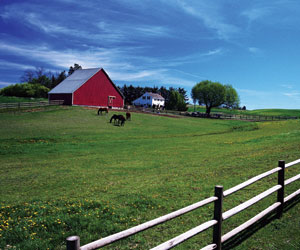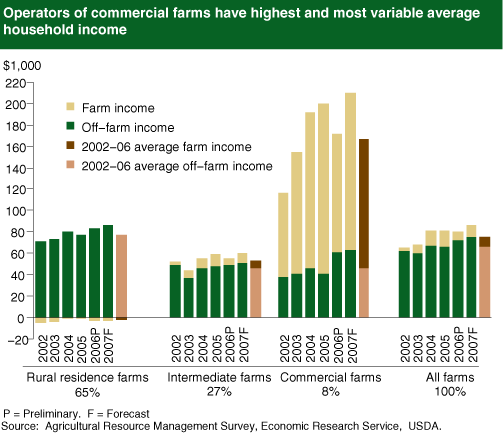 Latest
Indicators Point to Continued Strength of Farm Finances Latest
Indicators Point to Continued Strength of Farm Finances
Roger
Strickland, Farm Income and Costs
Mary Ahearn,
Farm Household Well-Being

Over the last two decades, U.S. farm net
cash income (earnings generated by production activities
that are available to pay debts and household living
expenses) largely has been increasing, as evidenced
by net cash income generally exceeding its 10-year
moving average. In 2007, even though farm expenses
are up, government payments to farms are down, and
some isolated regions are experiencing drought,
net
cash income is forecast at $85.9 billion, up
$18 billion from 2006 and $20.5 billion from its
10-year average. The recently released (August 30,
2007) estimate of farm income for 2006 and the forecast
for 2007 are the first estimates based on farm-reported
data for 2006 receipts and expenses.
Perhaps even more notable than
the sector’s strong income performance has
been the continued increase in farm sector equity
and the record-low debt-to-asset ratio. Farm
equity has increased in real terms for 16 consecutive
years. Growth in farm asset and debt values reflects
farm investors’ and lenders’ expectations
about long-term profitability of farm sector investments.
Farmland and building values of the farm sector—about
85 percent of farm asset values--are expected to
rise by nearly 13.7 percent in 2007. This solid
growth in farm real estate asset values is largely
due to favorable returns to farm assets over much
of the period. In addition, nonfarm demand for farmland
for recreation and nonfarm development will continue
to exert upward pressure on U.S. farmland values,
especially in urban and urbanizing areas.
By itself, net income of the farm
sector or of farm businesses is not an indicator
of the well-being of farm operator households because
other stakeholders in farming, such as landlords
and contractors, also receive some of the returns
of net farm income. In addition, besides farm investments,
farm operator households may depend on nonfarm investments,
jobs, businesses, and other links to the nonfarm
economy that are separate from their farming interests.
Moreover, farm household well-being may be affected
by other factors, such as health insurance coverage,
that are not relevant in a business sense.
The average
farm operator household income from farm and
off-farm sources, in 2006 was $86,694. This is 20
percent greater than the average income of the general
U.S. population; average farm operator household
income has exceeded the average of all U.S. households
for more than a decade.
Because the majority of farms
are small rural residences, but the majority of
production is on large farms, it is meaningful to
consider the financial position of farm operator
households by the size of the farm they operate.
Commercial farm households (the largest 8 percent
of family farms) rely more on farm income than other
farm households. Their household incomes are projected
to average over $200,000 in 2007, compared with
$60,029 for intermediate farms and $83,105 for rural
residence farms.
For the first time, ERS has developed
an estimate of the share of farm operator household
members who do not have health
insurance. In the past, many economists speculated
that the uninsured would account for a large share
of the farm population because farmers are self-employed,
although most also have off-farm work. In fact,
13.8 percent of persons in farm operator households
were uninsured in 2006. This compares with 15.8
percent of the general U.S. population.

|